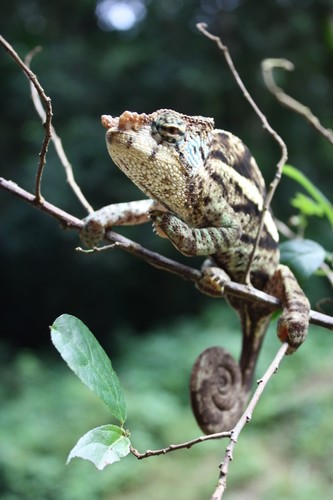Mount amber globe-horned chameleon
A species of Cryptic chameleon Scientific name : Calumma ambreense Genus : Cryptic chameleon
Mount amber globe-horned chameleon, A species of Cryptic chameleon
Scientific name: Calumma ambreense
Genus: Cryptic chameleon
Content
Description General Info
 Photo By marcoschmidtffm , used under CC-BY-NC-SA-4.0 /Cropped and compressed from original
Photo By marcoschmidtffm , used under CC-BY-NC-SA-4.0 /Cropped and compressed from original Description
Characterized by its arboreal habitat, mount amber globe-horned chameleon predominantly resides in the montane forests of Madagascar. With a peculiar diet consisting largely of insects and small invertebrates, it exhibits a pronounced hunting strategy: through its exceptional camouflaging abilities, the reptile patiently waits for prey to approach. Also noteworthy is the chameleon's ovoviviparous reproduction, in which eggs hatch within the female's body, strengthening offspring survival rates in harsh environments.
General Info
Lifespan
5-8 years
Diet
Mount amber globe-horned chameleon, a type of chameleon, exhibits a carnivorous diet, feeding primarily on small invertebrates. Its diet heavily consists of insects, including beetles, wasps, and caterpillars, captured by its quick and elongated tongue.
Appearance
The mount amber globe-horned chameleon is a medium-sized chameleon characterized by its triangular shaped head, elongated body, and smooth skin. Its color varies from green to brown with some specimens displaying pronounced stripes on their flanks. A most notable feature is a large, retractable rostral appendage present in males. This species shows little variation in appearance across different ages or sexes, with the exception of the prominent rostral appendage in males.
Behavior
Mount amber globe-horned chameleon are solitaristic creatures by nature, inhabiting the rugged terrain of their natural arboreal habitats. Their distinctive behavior encompasses skillful use of camouflage, typically employed for survival against predators. Remarkably adept climbers, they forage primarily during daytime hours. No distinct territorial behavior has been observed.
Population
Stable